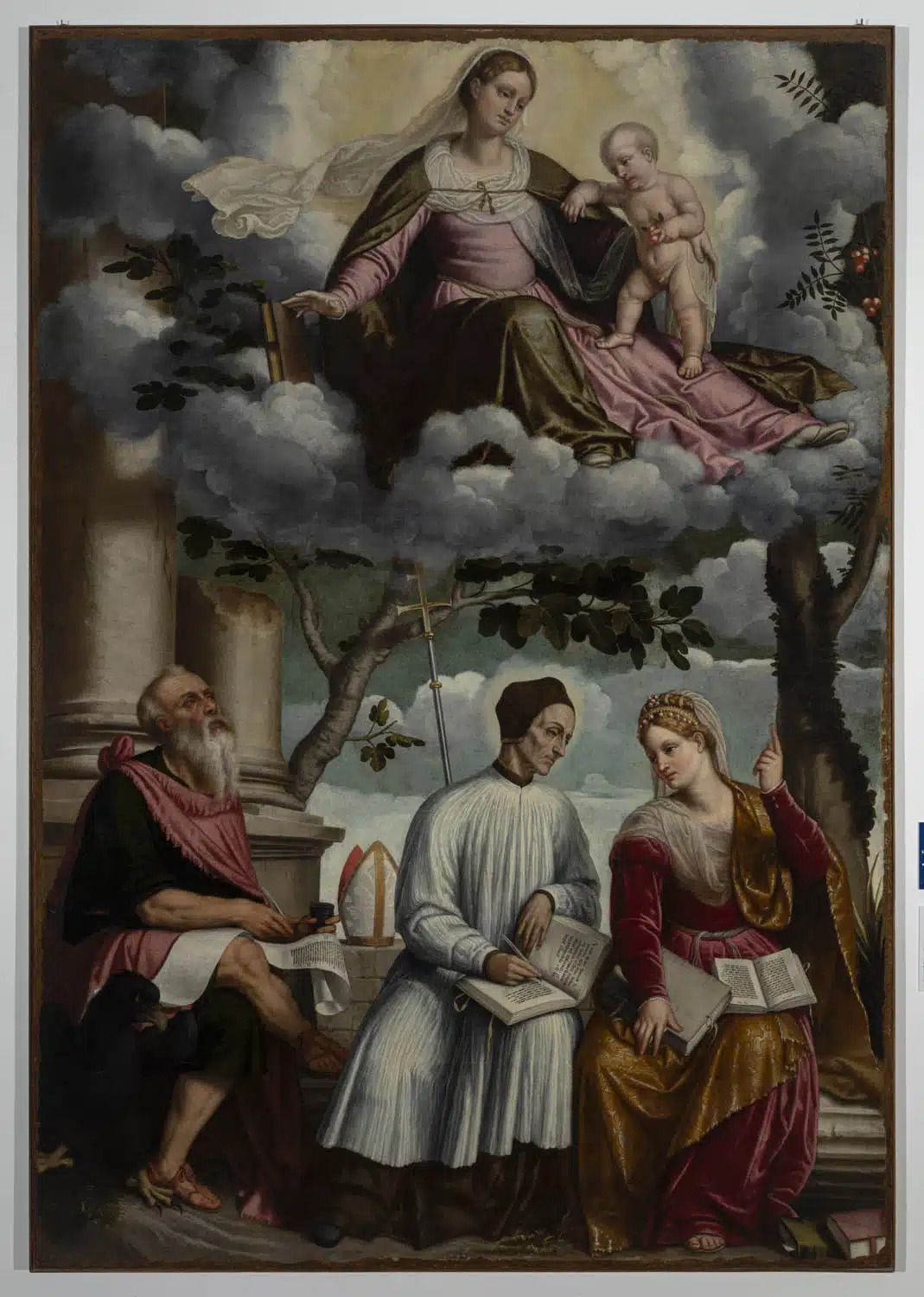The Madonna and Child in Glory, St John the Evangelist, Blessed Lorenzo Giustiniani and the allegory of Divine Wisdom
Author: Alessandro Bonvicino, il Moretto (Brescia 1498 circa – 1554) - 272 x 190 cm Provenance Brescia, Palazzo Vescovile -
The painting was commissioned to the artist Moretto by the Canons Regular of San Giorgio in Alga, a holy congregation born in Venice at the end of the XIV century and present in Brescia since 1437 in the monastery of San Pietro in Oliveto.
It decorated the first altar on the right of the church, entitled to St. Lorenzo Giustiniani, one of the founders of the Congregation, then abolished in 1668 by pope Clement XIV.
After the ownership of the Order of the Discalced Carmelites (in turn abolished on July 28, 1798, by the Cisalpine Republic), the whole monastery was sold to the Bishop of Brescia for housing the Seminary.
With the law of July 15, 1866, the Government of the newborn Kingdom of Italy decided on the passage of property of the monastery to the public domain and the dissipation of its artworks.
The painting of Moretto was then placed in a room near the sacristy of the Duomo Vecchio before being moved again to the chapel of the Palace of the Bishop.
The very complex iconographic subject had been already recognized in the XVII century by Bernardino Faino, who suggested the female figure to be an allegory of the Holy Wisdom.
It was then Francesco Paglia, in his Giardino della pittura, a precious guide to the artistic treasures of Brescia printed in 1713, who described more thoroughly the scene, the gestures, the glances, and the intertwining of speeches among the characters.
The episode is divided on the canvas into two sections. It depicts a vision of the Holy Wisdom received bySan Lorenzo Giustiniani in the years of his youth. He speaks about the vision in his book Fasciculus Amoris in these terms: “Finally, a beautiful maid appeared in front of me, whose name I didn’t know: and she was brighter than the sun and sweeter than the balm. […] She claimed herself to be the Holy Wisdom of God; the same Wisdom born in the fullness of time for the reconciliation of men to God”.
The prominent saint is depicted at the center of the bottom part of the canvas while writing on a book opened upon his knees, on which are reported the following verses from the Book of Wisdom: “The Spirit of Wisdom came to me, which I donate now without envy – since I learned from it without deception. I do not hide its richness, and its splendor is unquenchable.”
His gaze is turned to the allegory of the Holy Wisdom, a woman richly dressed who is pointing with her left hand high up to the group of the Madonna with the Child, sitting on a throne made from clouds and supported by the braiding branches of the fig and the strawberry trees, which respectively symbolize the sweetness and the strictness of true wisdom.
Opposed to the woman is St. John the Evangelist with the eagle (his iconographic symbol) at his side. Moretto portrays him in the middle of a mystic vision that forces him to stop writing on the parchment unto his knees – a reference to his Book of Apocalypse.
Among art historians, there’s no agreement on the dating of the canvas since they put it in a considerable period from 1520 to 1545.
Most of them suggest a chronology near the 1550s because of some recalls, in the painting, of some previous Moretto’s artworks such as the Pala Morelli (1539) but also because of the clothes and the jewels dressed by the Holy Wisdom, which the painter meticulously describes – and are going to be the main topics for the poetry of some of Moretto’s scholars such as Luca Mombello and Agostino Galeazzi.





